Real News
24/7
FEATURED STORY
Part V
December 11, 2003
Wesley Clark is fourth Democratic
candidate touting his Jewish connections
by Ken Francis
Part I:
Descended from the
priestly caste of Kohen Part II:
Mirror, mirror on the wall,
who's the most kosher of them all? Part III:
The Clinton
Factor Part IV:
Calling General Backtrack!
Part V: Waco and Kosovo Part VI: coming soon
Part V: Waco and Kosovo
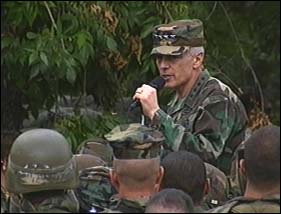 |
|
Wes's War
Shown here addressing troops, General Wesley Clark wrote
the book on modern warfare or, at least, a book, Waging
Modern War. Some critics, however, say more can be learned about
his battlefield stratagems by observing the attacks on civilians at
Waco and Kosovo, said to have his fingerprints all over them.
|
When Retired U.S./NATO General Wesley Kanne Clark
announced his candidacy as a Democratic contender for President back in late
September, he immediately bolted to the top of the opinion polls, a lead he
sustained for over a month . But in recent weeks he fell into a tie for first,
and now, according to the latest
CNN/USA Today/Gallup
survey of Democrats, Clark has dropped behind former Vermont
Governor and abortion doctor Howard Dean by nine percentage points, 25%
to 17%.
While this waning in popularity can be attributed to various
causes, the recent flap over what critics say was Clark's involvement in the
2003 fiery deaths of over eighty people at the Branch Davidian religious
community in Waco, Texas, probably hasn't helped with the more conservative
Democratic voters. Initially, he refused when asked by an
Insight magazine
correspondent to be interviewed on the subject back in October. As it turned
out, this was but opening salvo of what would become a growing assault on
Clark's character, stemming from his purported role
in what many Americans perceive to be a senseless siege against citizens whose
"crimes," in most cases, amounted to no more than being members of a fringe
religious group and wanting to be left alone.
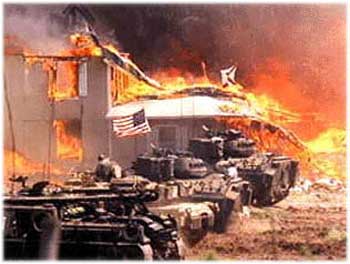 |
|
Overkill
defined The assault on the Branch Davidian religious sect by Federal
agents, resulting in the death of over 80 adults and children, is one of
the dark moments in U.S. history. The military vehicles used in the raid
came from a nearby army base, where they were under the command of General
Wesley Clark.
|
The allegations have continued unabated,
principally one of the few bastions of truly free speech left, the Internet.
So successful were the various websites and chat rooms in getting out the
Clark connection with this sordid page of history that finally some response
was deemed necessary. But even then, Clark avoided direct comment,
perhaps thinking that to do so would be to open the question at future press
conferences and other speaking engagements, a move that could prove costly. In
any case, he addressed the issue, as it were, by proxy:
An Army division
commanded by Wesley Clark supplied some of the military equipment for the
government's 51-day standoff with a religious sect in Waco, Texas, and Clark's
deputy, now the Army Chief of Staff, took part in a crucial Justice Department
meeting five days before the siege ended in disaster, according to military
records.
Clark's involvement in support of the Waco operation a decade ago was indirect
and fleeting, according to his former commanding officer. But the assistance
to civilian law enforcement agencies by military officers around Clark and
soldiers under his command has prompted a flurry of questions to his
presidential campaign. (Commanding
officer says Clark had no direct role in Waco siege)
In the article, which appeared in some newspapers under headlines seemingly
calculated to
derail his candidacy, Clark is bailed out by Army Lt. Gen. Horace Grady
"Pete" Taylor, who "takes the rap" for him, and campaign spokeswoman Mary
Jacoby. Mention, too, is made of the investigation (read whitewash)
conducted by President Bill Clinton's Justice Secretary
Janet Reno, who has much
culpability herself in ordering the Waco inferno.
"But critics," the article notes, "such as documentary filmmaker Michael
McNulty say there are many unanswered questions about the deaths at Waco,
including the nature of the military equipment that came out of Clark's
division and whether it was used." (Another critic of the government's
activities, Carol Valentine, who is curator of the
Waco Holocaust
Electronic Museum, believes that McNulty's film, Waco: Rules of
Engagement, is itself a
false opposition, but that's another issue.) There is considerable
evidence, contrary to the protestations of innocence by Taylor and Jacoby,
that Wesley Clark did, in deed, aid and abet the the horrific events of a
decade ago.
The government attack that brought about the
tragic deaths of nearly ninety (estimates vary) men, women and children on April
19, 2003 outside of Waco, is one of the defining moments of the Clinton
years and is indelibly seared into the memory of all Americans who old enough
to remember it. The siege that caused the fiery destruction of Mount Carmel,
the Branch Davidian sect's religious community, has come to epitomize the
consequences of the rejection of a fundamental principle upon which our nation
was founded: That its citizens are endowed by their Creator with certain inalienable
rights that no government, without just cause, can ever abridge. (Koresh
and the Waco siege)
Death came to the unsuspecting that fateful morning, when with reckless
disregard for human life—that's the more charitable view, others call it
murderous intent—booms attached to tanks and other combat vehicles smashed
through walls, it was contended, to introduce tear gas (never
minding, of course, that the very children they supposedly were trying to
rescue could have been struck and killed by such acts of vandalism).
Whether one chooses to believe the government's version or that of its
critics, the bottom line is that none of those people would have
perished had the Feds not employed strong arm (overkill in the most
literal sense) tactics to arrest one man, Vernon Howell
a.k.a. David Koresh, the group's leader—a man who easily could have been
arrested, probably without violence, in town weeks before.
Ostensibly, the attack was directed by the FBI and ATF, who acknowledged
the "loan" of military vehicles from nearby Fort Hood. But this doesn't
accurately tell what happened. For that information, we need to look
beyond the controlled media's sanitized version of events. One that
brings to into focus the involvement one General Clark, who
would later serve as the commander of the NATO forces that battled
Yugoslavia's Communist dictator Slobodan Milosevic (this latter
engagement, as will be shown in a moment, had much less to do with
securing freedom for oppressed people as it did with providing prep
work—like the Iraqi invasion—for the "peacekeeping" troops of an emerging world
government). Clark enlisted the aid of Yugoslav thugs to carry out
his plans in the War in
Kosovo.
At www.electwesleyclark.com
a biographical sketch of the candidate dryly lists among Wesley Clark's
accomplishments how:
As the
Commander 1st Cavalry Division, Fort Hood, Texas (August 1992-April 1994), he
transitioned the Division into a rapidly deployable force and conducted three
emergency deployments to Kuwait.
No mention, of course, of any involvement with the assault at Waco.
That is provided in the article "From
Waco to Belgrade: Wesley K. Clark and America's 'Army of the Future',"
where Ken McCarthy of
www.brasscheck.com writes:
The initial reaction of
virtually every person who hears about Clark's involvement
in the attack on the Mt. Carmel Center of the Branch Davidians outside of
Waco, Texas is
surprise and/or disbelief: "I thought it was an ATF/FBI operation that
went wrong
and all the military did was lend a few tanks."
Let's start by dispelling that myth. Here is the list of US military
personnel and
equipment that the US Justice Department admits were used at Mt. Carmel:
Military Personnel and Equipment
  |
|
"Rescue"
victim Eight-year-old Melissa Morrison, victim of the Waco Holocaust,
shown before (left) and after (right) her "liberation" by Federal agents.
Armored vehicles under General Wesley Clark's command were used in
carrying out the fateful attack.
|
Personnel
Active Duty Personnel - 15
Texas National Guard Personnel - 13
Track vehicles
Bradley fighting vehicle (OMZ) - 9
Combat Engineer Vehicle (M728) - 5
Tank Retrieval vehicle (M88) - 1
Abrams Tanks (M1A1) - 2
(Source: Department of the Treasury, Report of the Department of the Treasury on
the Bureau of
Alcohol, Tobacco, and Firearms Investigation of Vernon Wayne Howell also known
as David Koresh,
U.S. Government Printing Office, September 1993)
In other words, the
Waco raid represents a mini military assault (authorities said the virtually
indestructible Abrams tanks were being used because Branch Davidian leader David
Koresh had boasted about having anti-tank guns). "Attorney General Janet Reno,"
writes McCarthy, "attempted to explain away the 'FBI' use of US Army tanks as
being equivalent to an innocuous 'rent a car' arrangement." So why such a claim
from Reno? McCarthy offers this explanation:
No military commander "lends" 17 pieces of armor and 15 active service personnel
under his command to anybody,
let alone the FBI or any other law enforcement agency, willingly. The principle
is very simple: my men, my arms, my show.
In a lawful operation, the command structure would have been publicly announced,
but since the involvement
of the military in Waco was entirely illegal and indefensible, it was necessary
to paint the situation as an FBI operation. (emphasis added)
The obviously substantial presence of US military equipment used in the
operation was dismissed as being equivalent to a
"rent a car" service.
The US news media which received all of its information on Waco by dutifully
attending FBI press conference briefings and then repeating them uncritically
swallowed the "FBI in charge" story hook, line and sinker.
Whether
Clark actually helped direct the assault on the Branch Davidians using the
military force at Waco has not been documented, but it certainly came from his
command, with his knowledge and without any objection on his part. Kelly
Patricia O'Meara, in the Insight article mentioned at the beginning of
this section writes:
West Point
graduate Joseph Mehrten Jr. tells Insight, "Clark had to have knowledge about
the plan because there is no way anyone could have gotten combat vehicles off
that base without his OK. The M1A1 Abrams armor is classified 'Secret,' and
maybe even 'Top Secret,' and if it was deployed as muscle for something like
Waco there would have been National Firearms Act weapons issues. Each of these
M1A1 Abrams vehicles is armed with a 125-millimeter cannon, a 50-caliber
machine gun and two 30-caliber machine guns, which are all very heavily
controlled items, requiring controls much like a chain of legal custody. It is
of critical importance that such vehicles could not have been moved for use at
Waco without Clark's knowledge."
"This is something that the general staff would know in the daily situation
report or manning reports. Clark would have known and, given his obsession for
micromanagement, there is probably someone who can place him on the scene. He
wouldn't have been able to resist going in. At the very least there is no way
he didn't have knowledge," Mehrten continues.
So what if the general was aware that his military equipment was being used
against American civilians, and so what if he even participated in the
planning? Wasn't he just following orders from above?
"To follow that order," explains Mehrten, "is to follow a blatantly illegal
order of a kind every West Point officer knows is a violation of the Posse
Comitatus Act. Clark's obligation was to say, 'No, I'm not going to do it.'
Look, Clark went to the same institution I did and at West Point we had
extensive instruction in military ethics and issues concerning how one avoids
obeying an illegal military order. It is drilled into our heads from the
earliest days as cadets that the 'I-was-just-following-orders' defense isn't
necessarily a good one."
In short, even if Wesley Clark didn't directly assist in the Waco siege
(and we say, "if," because, as will be touched on at the end of
this, there are critics who have studied his career who insist that Waco
bears all the hallmarks of a Clark-led civilian assault), he must have
culpability in permitting the vehicles to leave Fort Hood. While Clark's
supporters within and without the military have come through for him this
campaign with much needed damage control concerning Waco, neither he nor
his have uttered a word of condemnation concerning the government's
heavy-handed tactics that played a crucial part in that tragedy. Some may
argue that by not commenting one way or another he is merely taking the
politically safer course, not seeking to alienate any potential voters
with differing views on the subject, but, at a very basic level , his
silence on the matter amounts to tacit approval.
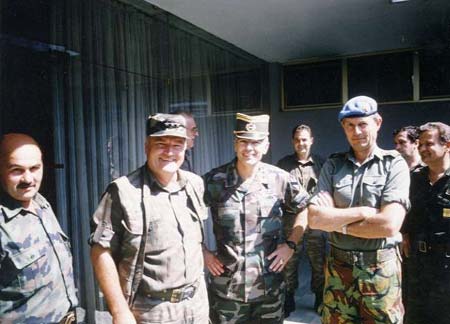 |
|
Birds of a
feather? A smiling Wesley Clark (center), then with the Joint Chiefs
of Staff, posed in 1994 with Bosnian Serb General Ratko Mladic
(second from left), wearing each other's hat. At the time Mlavic was
known in Washington as a suspected war criminal; it was later shown that
he ordered the murder of over 7500 unarmed Muslim males, aged 12-77, among
other brutal crimes. On the above occasion, the two drank wine together,
and Mlavic gave a bottle of brandy and an engraved pistol to Clark ,
who defends the meeting but now says he was wrong to have accepted the
gifts.
|
After Waco, General Clark received a number of
promotions, eventually ending up as commander of NATO forces during the
Kosovo War. Whether his promotions came as result of involvement with the Waco
slaughter, as some have maintained, is conjecture, but what isn't conjecture
is the death of more innocent civilians in the former Yugoslavia by soldiers
under his leadership. As mentioned above, Clark had no qualms about working
with street toughs. Later this month he is scheduled to testify in the
Netherlands at the United Nations war crimes trial of Slobodan Milosevic. (Clark
set to testify at trial of Milosevic) While discussing this on Meet the
Press in November, Clark defended a friendly meeting he had with one of
Milosevic's henchmen, General Ratko Mladic (see photo below), who is also
wanted for war crimes, including the "ethnic cleansing" massacre of over 7500
Muslim men and boys in the enclave of Srebrenica, an act some describe as "the
worst atrocity in Europe since World War II." (BBC
Profile: Ratko Mladic) He is presently being sought by
Interpol.
A U.S. official has compared Clark's
meeting with Mladic to "cavorting with Hermann Goering," the Nazi
Reichsmarshall and Luftwaffe-Chief who committed suicide at the Nuremburg
trials, after being sentenced to death for crimes committed during World
War II. Clark defends it by saying Mladic was not indicted at the time and
the meeting was to help bring about a peace treaty. A website supporting
Clark quotes his book, Waging Modern War, in which he
writes:
Meeting with Mladic was
especially useful. Although the United States had not taken sides
officially in the conflict, our concerns were clear. How many people, I
reflected at the time, have the opportunity to size up a potential
adversary face-to-face? He carried a reputation among the UN forces for
cunning and forcefulness, I found him coarse and boastful. He knew far
less than he thought about NATO, airpower, and the capabilities of the
United States. (Clarkmyths.com)
But Mladic was on a government "watch" list of suspected war criminals
when he met with Clark. Further, Clark was in violation of State Department's
express wishes that he not to meet with the Serb. According to a World
New Daily article: "The State Department immediately went into damage-control
mode and cabled European embassies to assure them of no change in U.S. policy
toward the Bosnian Serbs." (Clark
hobnobbed with war criminal) So, while Clark and his apologists downplay
the incident as a one-time occasion, the reality was different; his climb up
the ranks is said to have stalled for a time at three stars because of his
palling around with the bloody murderer.
Wesley Clark's meeting with Radko Mladic, though, is far from his last
friendly encounter with the sort of uniformed hoodlums American soldiers
in the past risked their very lives to defeat. After assuming the NATO
Supreme command in1997, Clark had close ties with Kosovo Liberation Army (KLA)
Chief of Staff Commander Brigadier Agim Ceku and KLA Leader Hashim Thaci,
ties which cannot be so easily explained away.
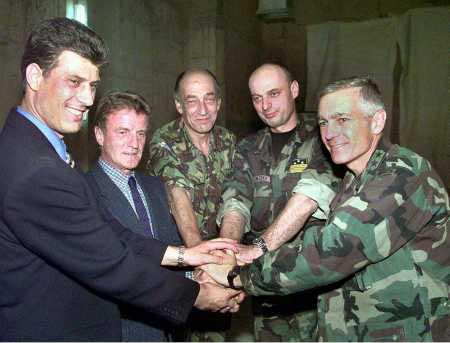 |
|
Terrorists
for "peace" This September 1999 photo shows Supreme NATO Commander
Wesley Clark (right) , along with other NATO officers in a show of
unity with Kosovo Liberation Army leaders Hashim "Snake" Thaci (left)
and Agim Ceku (next to Clark). The KLA, sold to the West as "freedom
fighters," committed massacres, assassinations and other war crimes,
engaged in narcotics trafficking and had ties to Osama bin Laden. Unlike
his apparent once-only meeting in passing with Ratko Mladic, Clark had
close ties to the KLA. Unlike other war criminals, not only did Ceku and
Thaci escape prosecution, they have prospered in post-war Kosovo.
|
The KLA has justly been described as a group of Marxist-Leninist "narco-terrorists,"
signifying both its attacks on innocent civilians and its involvement in
the illegal drug trade. Despite this well-documented reputation or,
perhaps, oblivious to it, Senator Joe Lieberman said: "The United States
of America and the Kosovo Liberation Army stand for the same values and
principles . . . Fighting for the KLA is fighting for human rights and
American values." (Washington Post, Apr.28, 1999) As William Norman
Grigg, a senior editor of The New American, points out, Lieberman's
equating of Communist thugs with our high-minded principles was seconded
by American and British military leaders (including General Wesley Clark)
stationed in Kosovo during the war there:
In congressional testimony
last December, Ralf Mutschke, assistant director for Interpol’s Criminal
Intelligence Directorate, noted: "In 1998, the U.S. State Department
listed the KLA as a terrorist organization, indicating that it was
financing its operations with money from the international heroin trade
and loans from Islamic countries and individuals, among them allegedly
Osama bin Laden." According to Mutschke, bin Laden also lent to the KLA
the services of one of his military commanders, who led "an elite KLA unit
during the Kosovo conflict." (For more on the Islamic connection, visit
KLA-Islamic Links.)
While funding for the KLA may have come from bin Laden, as Mutschke
pointed out, training for the KLA’s leaders came from American and British
special forces and intelligence personnel. The March 12, 2000 issue of the
London Sunday Times disclosed that "American intelligence agents have
admitted they helped to train the Kosovo Liberation Army before NATO’s
bombing of Yugoslavia," which began in March 1999. CIA officers who were
sent to Kosovo supposedly to monitor a cease-fire between the KLA and the
Serbian government actually spent their time "developing ties with the KLA
and giving American military training manuals and field advice on fighting
the Yugoslav army and Serbian police." They also gave KLA commandos such
gifts as "satellite telephones and global positioning systems." In
fact, several KLA commanders "had the mobile phone number of General
Wesley Clark, the NATO commander." (Emphasis added;
Behind the Terror Network Apparently, Clark's wasn't the only phone
number of an important American possessed by the KLA. Mary Mostert writes:
"The group suddenly burst on the world stage in 1998 as the favorite of
the Clinton administration under then Secretary of State Madeline
Albright, who was reported to have supplied KLA leader, Hasim Thaci, a
satellite phone and her personal telephone number.
Wesley Clark, defender of KLA terrorists, joins race to White House)
The March 27th issue of The Herald of London revealed: "Both the UK and the US
set up clandestine camps inside Albania to teach the KLA effective guerilla
tactics.... Despite government denials on both sides of the Atlantic, SAS
[British Special Forces] and US Delta Force instructors were used to train
Kosovar Volunteers in weapons handling, demolition and ambush techniques, and
basic organization."
To judge from its background, the KLA would seem an unlikely recipient of such
favorable attention from the West. New York Times Balkans correspondent Chris
Hedges points out that the group’s leadership is composed of "diehard
Marxist-Leninists (who were bankrolled in the old days by the Stalinist
dictatorship next door in Albania) as well as descendants of the fascist
militias raised by the Italians in World War II." The January 21, 1999, issue
of the French journal Liberation described the KLA as "totalitarian in its
methods," and reported that its leaders have "remained largely true to the
Maoist origins of its founders."
In 1993 Croatian Army Brigader General Agim
Ceku (later in charge of the KLA) masterminded what is sometimes referred to
as the Medak Pocket, a "scorched earth operation" that resulted in the total
destruction of three Serbian villages and the massacre of over 100 civilians.
From a report of Canadian "peacekeeping" forces, we read:
As the sun rose over the horizon, it revealed a Medak Valley engulfed in smoke
and flames. As the frustrated soldiers of 2PPCLI waited for the order to move
forward into the pocket, shots and screams still rang out as the ethnic
cleansing continued.... About 20 members of the international press had tagged
along, anxious to see the Medak battleground. Calvin [a Canadian officer]
called an informal press conference at the head of the column and loudly
accused the Croats of trying to hide war crimes against the Serb inhabitants.
The Croats started withdrawing back to their old lines, taking with them
whatever loot they hadn't destroyed. All livestock had been killed and houses
torched. French reconnaissance troops and the Canadian command element pushed
up the valley and soon began to find bodies of Serb civilians, some already
decomposing, others freshly slaughtered.... Finally, on the drizzly morning of
Sept. 17, teams of UN civilian police arrived to probe the smoldering ruins
for murder victims. Rotting corpses lying out in the open were catalogued,
then turned over to the peacekeepers for burial. (Cited, Michel Chossudovsky,
NATO has
installed a reign of terror in Kosovo)
Two years later, Clark crony Ceku headed Operation Storm, an
ethnic-cleansing effort many analysts believe was tacitly approved by NATO,
which may also have supplied advisors for the offensive. Operation Storm
sought to regain control of the Krajina region by driving out the Serbs and
brutality was, once again, in much evidence:
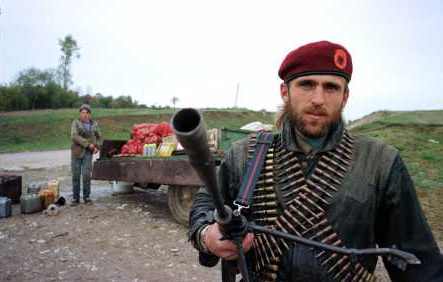 |
|
Taliban,
Kosovo style A well-armed "freedom fighter" of the KLA, the
terrorist group favored by Clark. It was funded by various Islamic
nations and individuals, including Osama bin Laden, and by its heroin
sales.
|
According to an Amnesty
International report, “Croatia: Impunity for killings after 'Storm,'”
nearly the entire ethnic Serbian population of the region, estimated to be
at least 180,000 people, fled in face of the attack. Hundreds of civilians
were murdered, most of the victims being elderly and disabled persons who
were unable to flee. The report estimates that 5,000 structures were
torched by the advancing Croatian army.
According to The New York Times, the International Criminal
Tribunal for the Former Yugoslavia has determined that war crimes were
indeed committed during Operation Storm. In a March 21, 1999 article, the
Times revealed an unpublished report produced by the Tribunal. Among the
report's assertions: “During the course of the military offensive, the
Croatian armed forces and special police committed numerous violations of
international humanitarian law.”
Hashim Thaci, the Kosovo Liberation Army's political leader backed by
Clark and NATO, has his share of skeletons in his closet. Grigg writes:
During NATO’s 78-day bombing
campaign against Serbia, the Clinton administration courted KLA frontman
Hashim Thaci, who has since been given a position of prominence in the
provincial government. This despite the fact that Thaci, as the June 25,
1999, New York Times reported, "carried out assassinations,
arrests, and purges" of potential rivals for power. Thaci, whose nom de
guerre was "Snake," counted among his victims a journalist named Ali
Uka, who had made the mistake of publicly criticizing the KLA. Shortly
thereafter, recalled the Times, Uka "was found dead in his
apartment in Tirana, his face disfigured by repeated stabbings with a
screwdriver and the jagged edge of a broken bottle."
When the crimes of
the KLA became widely known, Ceku, Thaci and company did the same thing that
many Eastern Bloc Communists seeking respectability in the West have done
since the fictitious fall of Communism¼its
name was changed. In part 1 of the article, "Terrorists
attacking Macedonia are NATO troops, not 'rebels"", Jared Israel writes:
The Kosovo Protection Corps (KPC) was created out of the Kosovo Liberation
Army by UNMIK, the United Nations administration in Kosovo. UNMIK simply
gave the KLA terrorists new uniforms, new equipment, a new name, official
UN status, a nice paycheck and a familiar racist-murderer for a leader
[Real News 24/7: that is, Ceku].
This was taking place in
September 1999, at around the same time Ceku posed with Clark in the above
photo. Despite his new uniform, big shot NATO buddies and identity as a
U.N. "peacekeeper," Ceku was still up to his old tricks. Concerning this,
Israel notes:
Now jump ahead to September
1999. This was the height of a second massive "ethnic cleansing" - this
time the KLA was driving Serbs, "Gypsies," Slavic Muslims, Jews and others
from Kosovo. And so Agim Ceku, veteran of Krajina in 1995 and Kosovo in
the summer of 1999 - the two worst racist military assaults in Europe
since World War II - became head of the Kosovo Protection Corps.
Meanwhile, Hasim Thaci set himself up ruler of Kosovo, a move which
Clark and company also approved. The political arm of the KLA, Thaci's
bailiwick, became known as the "Democratic Party of Kosovo," while
there was nothing truly democratic about it at all.
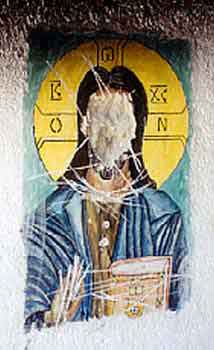 |
|
Christos
defaced This icon was the target of attacks by
the Kosovo Liberation Army, who have made the desecration and
destruction of churches, monasteries and graveyards a high priority.
"The ancient churches," declared an Orthodox bishop, "many of which had
survived 500 years of Ottoman Moslem rule, could not survive 8 months of
internationally guaranteed peace. Regretfully, all of this happens in
the presence of KFOR and the U.N."
|
What was the relationship between Wesley Clark and KLA? In essence,
they were part of the same fighting force. Mary Mostert, writing in the
article cited above, states:
On February 18, 1999, at a
Pentagon briefing on Kosovo, Captain Mike Doubleday observed, in trying to
explain to a skeptical reporter who was concerned about the Air Force
being manipulated by the KLA terrorists, "We are going to be very watchful
that that kind of an occurrence does not happen, and we are not going to
become an Air Force for the KLA."
Five days later, Senator Bob Smith, Republican of New Hampshire said on
the floor of the Senate on February 23, 1999 stated, "We are in essence
becoming the Air Force for the KLA."
Just as the KLA attacked civilians
on the ground without hesitation, so Clark showed little regard for them in
his air attacks. One of the targets of NATO bombers was the home of Slobodan
Milosevic, despite its being located in a residential area. Hospitals, old-age
homes, maternity wards and health clinics also were hit, as was the Serbian
television station in Belgrade. Clark's callous disregard for human life can
be seen in the following passage:
NATO justified the bombing of
the Belgrade TV station, saying it was a legitimate military target.
"We've struck at his TV stations and transmitters because they're as much
a part of his military machine prolonging and promoting this conflict as
his army and security forces," U.S. General Wesley Clark explained--"his,"
of course, referring to Yugoslavian President Slobodan Milosevic. It
wasn't Milosevic, however, who was killed when the Belgrade studios were
bombed on April 23, but rather 20 journalists, technicians [Real News
24/7: including a makeup lady] and other civilians. (Wesley
Clark: A war criminal?)
Also targeted were churches and monasteries. Colonel George
Jatras, USAF (Ret.), who publicly challenged Clark about his record in Kosovo
during a book-signing by the general in 2001, writes:
For those in the audience who did not have a flier, I began to explain the
picture which showed General Clark in a congratulatory handshake with Hashim
Thaci, leader of the KLA, which under the noses of KFOR [Real News 24/7: an
anagram for Kosovo Forces—the name for NATO forces in the region] had murdered
or ethnically cleansed thousands of Kosovo Serbs and had destroyed more
Orthodox Christian churches and monasteries than were destroyed in 500 years
under the Ottoman Empire. (Gen.
Clark at Borders)
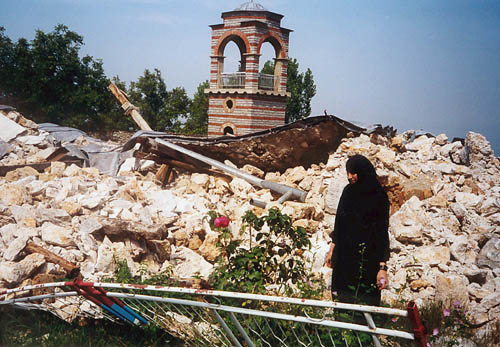 |
|
KLA
handiwork A Serbian Orthodox nun surveys the
ruins of the 14th century Holy Trinity Monastery, after it was
demolished by the Kosovo Liberation Army in July 1999—two months before
the KLA's Agim Ceku was named head of the NATO-sponsored Kosovo
Protection Corps.
|
Colonel Jatras is not exaggerating. On the
Crucified Kosovo
webpage is a "Catalog of destroyed and desecrated Churches in Kosovo and
Metohia" (click on church/monastery name to access before/after photos),
while a map shows the
locations at which the crimes were committed. Although the list only
pertains to a five month period in 1999, no fewer than 76 attacks are
reported. A search of the word "churches" on the
Balkan Peace
website pulls up scores of links on the
related subjects. Sometimes the troops of the KLA would leave a crude
graffito signifying their presence, such as "UCK" (the Albanian equivalent
of "KLA") scrawled across an icon. (See photo included in the report,
Destruction of Christian churches and monasteries in Kosovo and Metohija
since arrival of NATO, complied by the Berkley Kolo of
Serbian-American Sisters.)
The anti-Orthodox campaign did not not stop at
the harming of religious structures. A post from Belgrade on June
11, 1999, reports that
According to the news agency
AFP, Orthodox Bishop Artemije of Kosovo revealed that this week the Kosovo
Liberation Army set two medieval monasteries on fire and killed a priest. The
Bishop said that on Wednesday night he fled from Prizren, a city in the south
of the province with some 250 Serbs, several of them religious, to the
monastery of Gracanica, in the south of Pristina. (KLA
Burns Two Monasteries)
As this murder was reported internationally at
the time, it is virtually impossible that General Wesley Clark was
ignorant it. Yet just three months later, he was rubbing elbows with KLA
terrorists. They were our "allies," don't you know? Much more on this
important issue can be found at Kosovo.com, which includes a webpage entitled
Destruction, which has
extensive links, photos and videos. One of the links—Systematic
Destruction—proves that this sort of activity continued at least into late
2002 and, again, with the tacit approval of NATO/U.N.
What became of Clark
cronies Agim Ceku and Hashim Thaci? Well, not all war criminals are created
equal: While Milosevic is standing trial in the Hague and a $5 million reward
is being offered for the capture of the still-at-large Mladic, Ceku and Thaci
are doing quite well, thank you. According to a item carried on December 8 of
this year by the Balkan Reconstruction, the pair still have prominent
positions in Kosovo: Ceku is still commander of the so-called Kosovo
Protection Corps (who's being protected?) and Thaci heads the Kosovo
Democratic Party. (Suspicions
and Suspensions More on
Ceku)
Some analysts contend that by studying Wesley Clark's tactics and behavior
in Kosovo, one can see disturbing parallels with the Waco raid, parallels
that point to his involvement in blueprinting the earlier civilian slaughter. Lowell Ponte, in
Wesley
Clark and Waco, cites Alexander Cockburn and Jeffrey St. Clair on
similarities between the Mt. Carmel conflagration and Kosovo:
“Certainly the Waco
onslaught bears characteristics typical of Gen.
Wesley Clark: the eagerness to
take out the leader (viz., the Clark-ordered bombing of Milosevic’s private
residence); the utter disregard for the lives of innocent men, women and
children; the arrogant miscalculations about the effects of force; disregard for
law, whether of the Posse Comitatus Act governing military actions within the
United States or, abroad, the purview of the Nuremberg laws on war crimes and
attacks on civilians….The role of the US Army [at Waco] throws into harsh relief
the way prohibitions against the use of the US military for civilian law
enforcement can be swiftly by-passed.” (Ponte links the Cockburn-St. Clair
article.)
But these aren't the only similarities. An article carried by the
American Free Press identifies seven, including:
- Symbolic destruction of property dear to the "bad guy" Yugoslavia:
Milosevic's private home was bombed repeatedly in spite of the fact that it
was not a military target and was located in a residential neighborhood.
Waco: Tank operators repeatedly rolled over and destroyed numerous vehicles
belonging to the church which Karesh, an avid car mechanic, had personally
worked on.
- Obsession with silencing the victim's "propaganda" Yugoslavia: Clark
repeatedly bombed Yugoslavian television and radio transmitters and
stations, even though NATO had promised in writing not to attack stations.
Several workers were killed in these attacks. Clark declared them
"legitimate military targets" though their only function was news reporting
and entertainment. Waco: One of the first acts of post-raid Waco was cutting
off the complex's phone system to anyone but the FBI and disabling its short
wave radio system. As the siege wore on, the electricity was also cut off,
turned back on, then cut off again.
- Mislabeling the nature of the attacking force Yugoslavia: The war was
painted as a NATO operation. In reality, the vast majority of funding,
manpower, aircraft, targeting and munitions were provided by the US and the
operation was commanded by a US general. The entire operation was in
violation of the NATO charter, US law, and the UN Charter. Waco: The assault
was painted as an ATF, then FBI operation. In reality, the training,
tactics, equipment and essential manpower were provided by the US military
and the operation was commanded by a US general. The entire operation was in
violation of US law.
- Failure to plan for obvious contingencies Yugoslavia: No meaningful
preparations were made for the likelihood of large numbers of refugees, who,
after all, the war was supposedly being fought on behalf of. However,
immense military power was arranged for. Waco: No ambulance was on call
during the initial raid in spite of the fact that over 100 armed agents were
involved and the complex housed numerous women and children as well as men
who were thought to be armed. However, a convoy of armored vehicles was
provided as a "backup." (General
Wesley Clark From Waco to Yugoslavia: The US military was at Waco For
the full list, scroll to near the bottom of the linked page, where it
follows another list of general similarities.)
The military record of Wesley Clark has shown reckless disregard for
innocent civilians and a contempt for Christians in particular. The prospect
of him sitting in the White House ought to cause apprehension in all
Americans who value their freedom, their property and even their lives.
After all, do we really need another Waco?
Part
VI: coming soon
Recently Featured Stories & Special Reports:
11-27 BBC documentary proves
Israeli army murdered Rachel Corrie
11-17 Rothschilds
conduct "Red Symphony"
10-7 The Arnold protest the news
media didn't tell you about
9-30
A clarification concerning
the Pentagon photos article
9-27
Wesley Clark is fourth Democratic candidate touting his Jewish connections
9-20 9-11
Pentagon photos show mystery engine part
Home
DISCLAIMER: Real News
24/7 does not necessary agree with every thought or the implication of
every article linked to, nor with every stand or position taken by the
person or organization responsible for an article recommended here. Nor do
those who wrote such articles necessarily agree with everything on this
website. Real News 24/7 assumes no responsibility for the opinions
expressed in any work taken from external links. In each section are listed
the best articles available at the time on a given subject with regard to
documentation and analysis of the subject under discussion, regardless of
minor or major flaws in the article. The content in Real News24/7
features is meant to bring to your attention information or views generally
not easily found on the Big TV networks and other controlled media sources.








